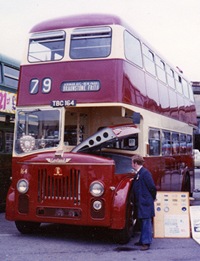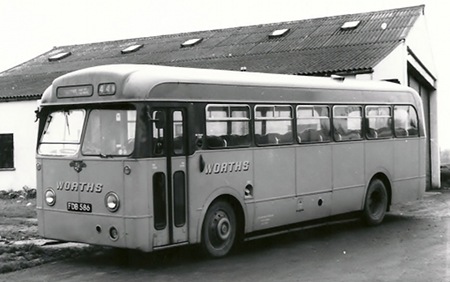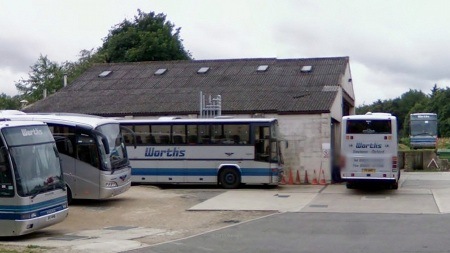Leicester City Transport – Leyland Titan PD3 – TBC 164 – 164
Leicester City Transport
1958
Leyland Titan PD3/1
Willowbrook H41/33R
LCT bought an eclectic mix of chassis and bodywork for its fleet over the decades, but settled on just three (164-166) tin-fronted Leyland Titan PD3/1’s, with attractive Willowbrook bodywork, in 1958. 165 and 166 were withdrawn in 1972 and 1975 respectively, with 164 being withdrawn in 1974. It’s seen here, looking remarkably chipper, aged 19, at the Bristol Bus Show, in 1977.
Photograph and Copy contributed by Chris Hebbron
29/09/12 – 07:43
And would the gent who looks as if he’s volunteering to become lunch be Mr Hebbron, by any chance?
Pete Davies
29/09/12 – 07:44
This bus is currently under restoration on a farm outside Leicester.
Philip Lamb
29/09/12 – 12:15
I thought it was at Snibston Discovery Park in Coalville, fully restored ages ago, along with a 6 wheel Renown and the 1911 Leicester City Transport Leyland tower wagon used up to the end of LCT Tramways in 1949. The latter is the oldest preserved Leyland lorry.
If the photo is 1974, Chris, and the figure looking in is not you, then it would be Clive; (sorry Clive, but I cannot remember your second name!). He was the regular Leicester Museums staff member who drove the exhibits to various shows when they were stationed at the Corporation Road Pumping Station Museum in Leicester. Probably still does, from Snibston. Other LCT buses are restored, or under restoration, by the Leicester Transport heritage Trust, including tram 36.
John Whitaker
29/09/12 – 18:03
Handsome bus, dignified livery. By the time I went up to university in 1984 the bus fleet had been standardised on MCW Metropolitans and Dennis Domintors with a few Metro-Scanias thrown in: but the fleet still sported the dignified cream and maroon-banded livery, some services were conductor-worked, and tickets dispensed from Ultimates and Solomatics . . . not for long though, the red/white/grey Leicester CityBus identity was adopted as part of the Leicester CityCouncil corporate identity (that’s right chaps, paint your buses the same colour as your refuse waggons so that passengers get the message), and Wayfarer machines came in. Most LCT services (except those worked jointly with Midland Red/Fox?) were cross-city and, I think until a route revision round about the time I went up, used different numbers depending on direction of travel. Leicester, like Trent, used to place front number plates at ‘tween decks level – any suggestions as to why? was this just a midlands foible, or did any other operators adopt this practice? Willowbrook seemed to have a respectable business amongst major operators for both single and double-deck business around this time, but then in the 1970s seemed to concentrate on the lightweight market: I suppose the introduction of the Leyland National killed-off the BET standard business, but why didn’t it continue to chase the double-deck market? And why did Duple buy Willowbrook and then divest itself of the business? Why did it keep the Willowbrook identity when Burlingham and Nudd Brothers & Lockyer became Duple (Northern) and Duple (Midland) – in fact, why wasn’t Willowbrook amalgamated with Duple (Midland)? Anyway, back to the bus: did Leicester pay extra for the Leyland badge? which would explain why not all tin-fronts sported this feature, but not why Leyland didn’t think it worth advertising itself on its products; and why, when the tin-front was adopted for wider use, did Leyland not modify the grill to eliminate the space for the BMMO badge? – surely the costs of re-tooling would have been miniscule when compared to production volumes. So many questions! Hopefully some answers will be forthcoming, in the meantime I’m going to scroll up and drool over the bus a bit more . . .
Philip Rushworth
30/09/12 – 07:57
Number plates between decks was not just a midlands foible Philip as Southdown did up until I think the late fifties when they moved them to below the cab windscreen for some reason although for obvious reasons the double deck coach No 700 with full front Northern Counties body always had it’s plate below the radiator grill.
I think the livery on the PD3 in the photo was far better than the later predominately cream version and the red/white/grey is best forgotten and the Midland Red front although not very stylish was infinitely superior to the St Helens front which was such an ugly brute which never suited any bodywork.
Diesel Dave
30/09/12 – 07:58
Philip Willowbrook did build some VRs and Atlanteans in the seventies principally for the Northern General companies sadly they were not a patch on this example Leicester’s last rear entrance bus an East Lancs bodied PD3 ran in 1982.
Why Leyland kept the tin front design until the early sixties without getting rid of the space for the BMMO badge I cannot say but Edinburgh fitted a version of it to all its Titans finally building a fibre glass version themselves.
The bodies built by Willowbrook were somewhat ersatz copies of ECW (the VR) and MCW products.
Chris Hough
30/09/12 – 10:40
If you go to your web page and type in AFT53 you’ll find a picture of Tynemouth 223 being used as a training bus, it was one of 5 Willowbrook bodied PD2/12’s delivered to Percy Main in 1957. AFT 49/53 – 219/223. The original livery layout was mostly red with cream center band and roof, later on the roof became red ‘I thought they looked best in that livery’ and about 1968 this updated version of the first post war layout was adopted. As far as I know these were the only ones of this type in the NGT group. Northern were never fans of tin fronts, in fact I think the Routemasters were the only ones that came close to that description
Ronnie Hoye
30/09/12 – 12:04
The tin front design question is an interesting one, as the Leyland grille design changed slightly over the years and I see nothing sacrosanct about the part with the space for the BMMO badge.
This photograph also makes clear why Orion bodies (in particular) on tin-front chassis, tapered in so much at the front. This was to match the width of the standard tin-front which was clearly to suit 7′-6" chassis. Willowbrook opted to maintain more body width to the front resulting in a mini dash panel to the offside of the tin front.
David Beilby
02/10/12 – 14:46
Diesel Dave comments on the ugliness of the St Helens front. I’m making the rash assumption here that St Helens Corporation thought it rather pretty!
Pete Davies
02/10/12 – 14:54
The figure is not me, Pete/John and the photo was taken in 1977, so may or may not be Clive. I was worried, myself, about the wisdom of examining the mechanicals in the bowels of the monster, so I kept well clear. One can never be too careful!
Chris Hebbron
03/10/12 – 06:00
Thanks for clarifying! It looks as if that lid could stand duty as a guillotine.
Pete Davies
03/10/12 – 06:01
The later Leyland concealed radiator design was known as the St Helens front, because St Helens was the first operator to take delivery. The design was pure Leyland — a reverse of the situation re the original Leyland tin front, which was developed to match contemporary Midland Red styling.
Philip Lamb
03/10/12 – 06:02
David, the tin front wasn’t designed to suit a 7ft 6in chassis. The original design, as we all know, was for BMMO and the order was for 100 8ft wide PD2s with Leyland bodies. Again, as we know, the standard Leyland 8ft wide body was a widening of the original 7ft 6in wide body.
For some reason Leyland widened all but the the front of the 8ft body. This didn’t cause any design problem with the traditional layout of radiator and front scuttle panel and, as the BMMO requirement for a tin front was expected to be only for them, the tin front was designed to blend with the body.
Whilst the tin front was eventually offered on both 7ft 6in and 8ft chassis, the BMMO order was the only one, in either width, to specify Leyland body work.
Liverpool adopted the tin front and its 1954 delivery of PD2/20s (8ft wide with bodies by Alexander) did not have the narrowing and the tin front on these vehicles was the full width of the bus – as were tin fronts on bodies by other builders for a range of operators using the 8ft wide chassis.
Doug Jack’s "The Leyland Bus" has a range of pictures showing a variety of 8 ft wide tin front PD2s without any narrowing of the body, some with full width tin fronts, some with the 7ft 6in version on 8ft wide bodies.
The question is why 8ft wide Orion bodies narrowed as they did to use the 7ft 6in version of the tin front.
The Edinburgh Holmes designed tin front replacement was unutterably ugly. As for the St Helens front, it was designed to give better visibility and Leyland saw it as being akin to the design on the current Vista lorry cab (which they shared with Dodge), thus giving a form of "house style".
Phil Blinkhorn
03/10/12 – 10:12
One of the attractions of this site is the wide scope of observations from correspondents with differing interests. With my ‘operational’ background, my reaction at the illustration was, as others have commented, of a smart vehicle in attractive livery, but I wondered about the destination display. The route numbers are large and very readable, which was fine for locals who knew where they were going, but the actual destination box itself isn’t too helpful for passengers who needed to check their intended destination, and is out of proportion with the numerical display. The positioning of the number plates is distracting, and doesn’t make things easier for them.
Roy Burke
04/10/12 – 07:22
Philip,
A reference in "Local Transport in St Helens 1879-1974" by TB Maund and MJ Ashton says "St Helens commissioned an unusual asymmetrical front which was subsequently used elsewhere and known as the ‘St Helens front’ ".
As a passenger on St Helens Corporation and Crosville to school from 1961-68, I always assumed that St Helens Titans had fibreglass fronts because Fibreglass Ltd (a subsidiary of Pilkington Brothers) were based in St Helens.
Thus, some Corporation spending was kept within the boundary and kept some local people in employment. This is something long-lost in our economy, much to the delight of Volvo, Scania etc.
Dave Farrier
04/10/12 – 13:35
On the subject of highly placed registration plates it may have been a geographical thing as both Trent and Barton also place them over the cab on double deckers.
Chris Hough
11/02/14 – 07:00
I worked for LCT for 5 years, and my understanding of the positioning of the number plates was that the body fitters were sick to death of having to refit them after minor shunts. So the chief engineer of the day, early 1960s, decreed that the damned things be removed to a higher place of safety. Presumably, other operators took the same view and for the same reason. A minor shunt, that maybe just dented the bottom of the grille, could be ignored until the next repaint, whereas damaged or missing number plates had to be attended to immediately or the vehicle was out of service until fixed.
Rob Haywood
11/08/14 – 07:16
The man looking at 164 is NOT Clive. It’s not me either but I did drive this to rallies when working for Leicester Museums and Clive Stevens worked for me. He still volunteers at Abbey Pumping Station Museum. We also drove the 1939 Renown, once all the way to Brighton.
Bob Bracegirdle
 Vehicle reminder shot for this posting
Vehicle reminder shot for this posting
02/11/14 – 15:24
As an ex. LCT employee, 1956-61, I can confirm that the positioning of the front number plate between decks came about long before tin fronts – pre WW.II in fact. It was positioned there so that reconditioned radiators could be swapped between buses without the necessity to swap number plates.
Paul Banbury
Quick links to the - Comments Page - Contact Page - Home Page





